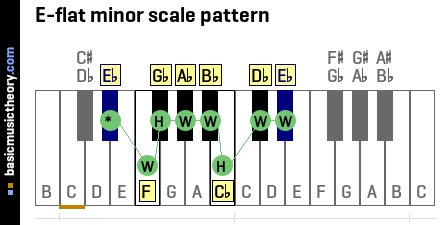Natural minor scale
| Key | C | C# | Db | D | D# | Eb | E | E# | Fb | F | F# | Gb | G | G# | Ab | A | A# | Bb | B | B# | Cb |
|---|
Structure
The terms minor scale and natural minor scale mean the same thing in music theory.
Natural minor scales contain 7 notes, and all use the W-H-W-W-H-W-W tone / half-tone pattern to identify the note positions.
The first note in the diagram below (*) is the tonic note, from which the counting pattern begins.
To count up a Whole tone, count up by two physical piano keys, either white or black.
To count up a Half-tone (semitone), count up from the last note up by one physical piano key, either white or black.
So in the example below, we are interested in the minor scale in the key of E-flat.
No matter which key name (or color - black / white) a major scale starts on, the same pattern above is used.
The 8th and final note in the diagram is the octave note, named the same as the tonic note, and is the note where the scale and tone / half-tone pattern rule starts repeating all the way up the piano keyboard.
To understand the frequency relationship between a tonic and its octave note, have a look at the Chromatic scale overview.
Examples
Below is an example using the Eb natural minor scale.

To learn about minor scales, start with the A natural minor scale, which has no sharps or flats, only white / natural notes.
In fact, it contains the same notes as the C major scale, but a different note is used as the starting (tonic) note in each case.
Then maybe have a look at the Eb natural minor scale as shown above, which contains 6 flats.
More complex still is the A# natural minor scale which has all 7 notes sharpened.
The All minor scales page contains piano diagrams and key signatures for all (natural) minor scales.
To understand the differences between the major and minor scale for a given key, have a look at any natural minor link on this page, which show the note differences for the specific key you are interested in.
To see the relationships between all major and minor scales on a diagram, have a look at the Circle of fifths diagram.